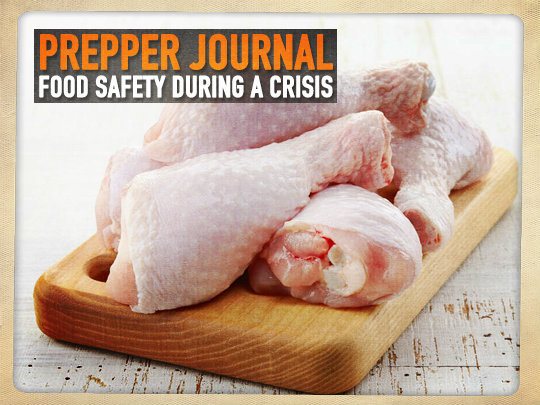
According to the Federal Government there are approximately 48 million cases of food borne illness annually. This equates to 1 in 6 people, and the illnesses result in 128,000 hospitalizations and 3,000 deaths. Anyone can be sickened, but the very young, the very old, and those with weakened immune systems are particularly susceptible (FDA, 2014).
Why do people become sick, they become sick because of bacteria in and on the foods that in some cases is not destroyed during the cooking process, in other words, the foods were not cooked to a high enough temperature to destroy the bacteria.
Others reasons include cross contamination, caused by food handlers that use cutting boards and counter tops to process a raw chicken, for example, and then fail to properly sanitize the area before processing foods, which may not be cooked at all, or not cooked to a high enough temperature to destroy bacteria present.
Certain vegetables, lettuce, and breads should never be cut up on a cutting board that was used for raw meats, unless the board is thoroughly disinfected between uses. Raw meats can also contaminate other foods in the refrigerator that may not require cooking if the raw meats are stored near or above the foods were juices can drip to contaminate other foods.
1.) Before handling any foods ensure your hands are cleaned properly so you do not contaminate the product especially if that product will not be cooked or heated to a sufficient temperature. If you handle raw meats and then fail to clean your hands, any surface or food you touch could possibly be contaminated with deadly bacteria.
2.) Separate your foods beginning in the supermarket. Use dedicated cutting boards for fresh meats and poultry and never use the boards for any breads or salad preparation. It is recommended that you have cutting boards just for raw meats and one for handling foods that would not be cooked such as breads, leafy greens for salads and so on. Separate all foods in the refrigerator so raw foods cannot contaminate other foods.
3.) Certain food products must be cooked to the correct internal temperature to ensure all bacteria is destroyed. See below for a chart with the proper cooking temperatures. This means you will need a quality thermometer to test foods before consuming.
Safe Cooking Temperatures as Measured With a Food Thermometer
- Ground Meat & Meat Mixtures Beef, Pork, Veal, Lamb160°F
- Turkey, Chicken 165°F
- Fresh Beef, Pork, Veal, & Lamb 145°F with a 3 minute rest time
- Poultry Chicken & Turkey, Whole 165°F
- Poultry Parts 165°F
- Duck & Goose 165°F
- Stuffing (cooked alone/in bird) 165°F
- Ham Fresh (raw) 145°F with a 3 minute rest time
- Pre-cooked Ham (to reheat) 140°F
- Eggs & Egg Dishes Eggs Cook until yolk & white are firm
- Egg Dishes 160°F
- Seafood Fin Fish 145°F or flesh is opaque & separates easily with fork
- Shrimp, Lobster & Crabs Flesh pearly & opaque
- Clams, Oysters & Mussels Shells open during cooking
- Scallops Milky white or opaque & firm
- Leftovers & Casseroles 165°F
Once the power goes out the perishable foods in your refrigerator if it is full, will last up to six hours, if half full or less, then only four hours. Freezers if full can maintain a safe temperature up to 48 hours. Obviously opening the doors too often will have an impact on how the long the foods can last.
Freeze plastic jugs filled with water to take up space in freezers so the foods stay cold longer during an outage. Any perishable foods held at 40° F or higher for longer than two hours are not safe to eat. Once cooked, foods must be held at 135°F. This is important if you are heating or reheating food using gel fuels under serving pans.
Once the power has been out for longer than six hours the perishables in your refrigerator should be disposed of. Bacteria can grow rapidly once foods begin to warm up and spoilage will begin. Breads can be allowed to go stale by removing the packaging. Once the moisture has been evaporated mold growth will be slowed. Breads can be toasted, if you have the means to do so, to preserve the product.
Most produce and fruits with the skin still on can be left on the counter up to five days. Dry any produce thoroughly once you remove from the refrigerator, because bacteria thrives in a moisture rich environment. You will be able to tell if the fruits and vegetables are edible or not by inspecting the product.
Eggs purchased from a retail store cannot be safely eaten if stored for more than two hours above 40° F degrees. If you raise your own eggs there are procedures you can follow that allow you to keep eggs out of refrigeration for an extended period. Make sure you know the procedure and do it correctly. Certain procedures include “water glass”, or coating the eggs in oil or lard.
Eggs processed commercially are cleaned and the outside sanitized, which in some people’s minds is the very reason eggs “store bought” have to be refrigerated. Eggs do not spoil setting under a hen so it is likely it has to do with the outer shell’s pores being cleaned, and thus, bacteria can penetrate the porous shell if left out of refrigeration.
You should have bleach available during a crisis so all food handling surfaces and cooking utensils can be disinfected. Clean water for washing hands and surfaces is critical along with an ample supply of clean cloths and/or paper towels. Disinfecting wipes can be used as well but read the label carefully to ensure they are not just cleaning wipes but that they also disinfect surfaces. Sanitation wipes are not for cleaning human hands or any part of the body.
FDA. (2014, December 18). Retrieved 2015, from http://www.fda.gov/food/resourcesforyou/consumers/ucm255180.htm